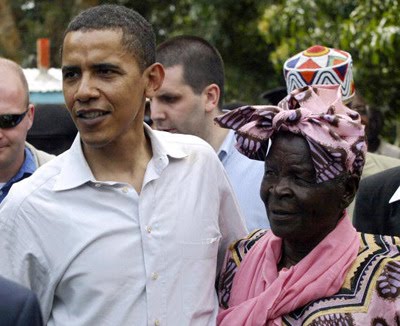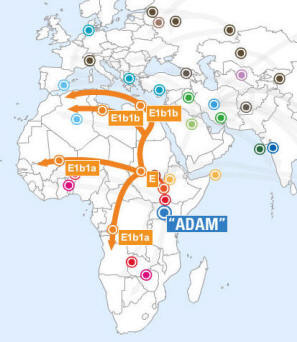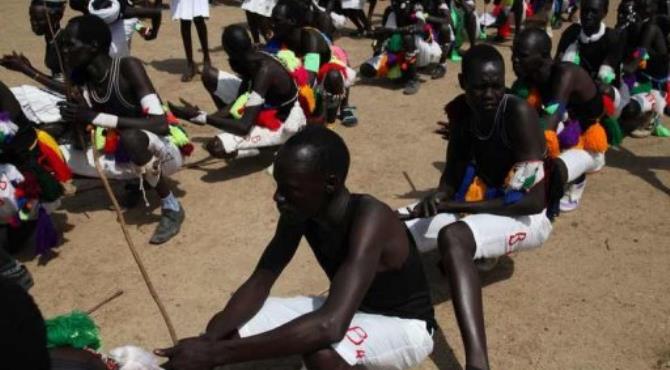|
|
Post by thamm1 on Feb 12, 2016 16:10:51 GMT -5
Every genetic study extant places the origins of haplogroup E either in Northeast Africa or in Eurasia. None associate the clade's origins directly with Negroid populations. Despite this, confusion (primarily among laypeople) seems to surround the haplogroup's population affinities. This mainly has to do with the fact that numerous (though not all) modern Negroid peoples carry the clade. This thread helps explain why they do, as well as how, when and through what mechanism(s) those Negroid peoples acquired haplogroup E in the first place from the Hamitic folk it originated with. While many Negroid populations today carry haplogroup E lineages, this was not the case only a few centuries ago. This has to do with the fact that: Read more: hamiticunion.proboards.com/thread/4/hamitic-origin-haplogroup#ixzz3zzJ11Jnc1) The oldest Negroid skeletal remains that have ever been found are only about 12,000 years old i.e. tens of thousands of years younger than when the mutation that defines haplogroup E first arose. "On the basis of genetic and archaeological data, black Africans seem to have radiated from a relatively small West African and possibly pygmy population within the last 20,000 years (Coon, 1962, pp. 651-656; Spurdle et al., 1994; Watson et al., 1996). The time and place of origin can be further narrowed down with linguistic data. Speakers of proto-Niger Congo broke up c. 10,000 BP and the oldest derived group appear to be proto-Mande speakers, whose descendants inhabit the Niger's headwaters near the Mali-Guinea border (Blench, 1984, pp. 128-129; Ehret, 1984; Murdock, 1959, pp. 44, 64-68)[...] Thus, black Africans were still absent from most of sub-Saharan Africa even within historic times. When the Egyptians began to build their pyramids, the peoples living to the south were scarcely darker in color. They were simply seen as uncivilized Egyptians. Thus, the civilized world initially encountered a much narrower range of human phenotypes than it would later on. This context shaped the intellectual worldview in its early stages, including theorizing on universal brotherhood. To a degree not easy to assess, we are heirs to notions of human sameness that were first conceived ‘before Africa became black’." Read more: hamiticunion.proboards.com/thread/4/hamitic-origin-haplogroup#ixzz3zzJ3jaQr |
|
|
|
Post by thamm1 on Feb 12, 2016 16:11:32 GMT -5
2) Haplogroup E and its parent clade haplogroup DE originated with Northeast Africans (or possibly even Near Easterners), not with Bantus. This is because Horners have the highest frequencies of haplogroup E, the highest variety of different sub-clades of the haplogroup (i.e. the highest diversity), and the exclusive presence of the oldest branches of the haplogroup. "The presence of two underived E-M96 Saudi lineages raises interesting questions related to the macrohaplogroup DE-YAP phylogeography. The recent resolutions of the CDEF-M168 tripartite structure to the bipartite DE-YAP and CF-P143 [16,31] extends the conversation regarding the early successful colonization of Eurasia. While several scenarios remain potentially possible the most parsimonious model is the most prudent. This model proposes the successful colonization of Eurasia by migration(s) of populations containing precursor Y-chromosome founder macrohaplogroup CDET-M168 and basal mtDNA L3 representatives. Regions near but external to northeast Africa, like the Levant or the southern Arabian Peninsula could have served as an incubator for the early diversification of non-African uniparental haplogroup varieties like Y chromosome DE-YAP*, CF-P143* and mtDNA M and N molecular ancestors. These would have spread globally and diversified over time and space. This model would imply that both CF-P143 and the DE-YAP evolved nearby but outside Africa. One DE-YAP* ancestor would have spread to Asia and evolved to haplogroup D while another DE-YAP* returned to northeast Africa and evolved into hg E." www.biomedcentral.com/1471-2156/10/59"Y-DNA haplogroup E would appear to have arisen in Northeast Africa based on the concentration and variety of E subclades in that area today. But the fact that Haplogroup E is closely linked with Haplogroup D, which is not found in Africa, leaves open the possibility that E first arose in the Near or Middle East and was subsequently carried into Africa by a back migration[...] E1b1b1 probably evolved either in Northeast Africa or the Near East and then expanded to the west--both north and south of the Mediterranean Sea. Eb1b1 clusters are seen today in Western Europe, Southeast Europe, the Near East, Northeast Africa and Northwest Africa." Read more: hamiticunion.proboards.com/thread/4/hamitic-origin-haplogroup#ixzz3zzJ5z1fj |
|
|
|
Post by thamm1 on Feb 12, 2016 16:12:55 GMT -5
3) Bantus only recently acquired the haplogroup by assimilating some Afro-Asiatic males in Northeast Africa, which is why the most common haplogroup E lineage Bantus possess (namely, E1b1a/E3a) is only about 10,000 years old. The haplogroup, along with the Bantu languages, was then spread to the rest of Sub-Saharan Africa by Bantu intermediaries via the Bantu expansion of 3500 years ago. "E1b1a is an African lineage that probably expanded from northern African to sub-Saharan and equatorial Africa with the Bantu agricultural expansion." www.isogg.org/tree/ISOGG_HapgrpE.htmlen.wikipedia.org/wiki/Bantu_expansion In the process, the migrating Bantus' paternal DNA (haplogroup E lineages) replaced the pre-existing Y-DNA haplogroups in the previously Khoisan, Pygmy (hunter-gatherer) and Afro-Asiatic-inhabited regions of southern and southeastern Africa that they invaded. "The data presented demonstrate a recent origin for most paternal lineages in west-central Africa as a result of the "Bantu expansion" that erased the Y-chromosome diversity previously found. However, some traces of ancient paternal lineages are found, mainly in hunter-gathererers. These results contrast with the data provided by mtDNA, where ancient lineages are found and substantial maternal gene flow from hunter-gatherers to Bantu-farmers has been suggested." Read more: hamiticunion.proboards.com/thread/4/hamitic-origin-haplogroup#ixzz3zzJ8c8Um |
|
|
|
Post by thamm1 on Feb 12, 2016 16:14:12 GMT -5
|
|
|
|
Post by thamm1 on Feb 12, 2016 16:14:43 GMT -5
5) Most Negroid peoples speak languages from the Niger-Congo, Nilo-Saharan and Khoisan language families -- none of which are genetically related to the Afro-Asiatic language family spoken by most Hamitic peoples. Afro-Asiatic's nearest relatives are language families that are overwhelmingly spoken by populations with Caucasoid physiognomies, together with which it is grouped in the Nostratic and Borean super-phylums. "It is clear that the Borean hypothesis involves a super-phylum some of whose sub-taxa are themselves super-phyla. The term phyletic chain is introduced as a better label, particularly because the Borean groups show a chain like distribution from southern Ethiopia through southwestern Eurasia to northeast Asia and down to the end of the New World. Borean has clear similarities to Swadesh's Vasco-Dene. Borean is predominantly associated with human populations of "Caucasoid" or "Northern Mongoloid" physical appearance, the major exceptions being southern India, southern China, southwestern Ethiopia, northern Nigeria, and the Chad Republic. Borean as a chain is closely associated with the appearance of the Upper Paleolithic in the Levant, Europe, and western Eurasia from 50,000 to 45,000 years ago." greenberg-conference.stanford.edu/Fleming_Abstract.htm starling.rinet.ru/maps/maps17.php?lan=en This at the very least suggests a proto-Caucasoid origin for not only haplogroup E, but for the more upstream haplogroup CT too. It also reinforces the observation that haplogroup E is not the original paternal lineage of Bantus, Nilotes and other Negroid populations, but rather one that they later acquired. Read more: hamiticunion.proboards.com/thread/4/hamitic-origin-haplogroup#ixzz3zzJDk6wg |
|
|
|
Post by thamm1 on Feb 12, 2016 16:18:40 GMT -5
 Cro-magnon present in north africa since at least 25 000 BP |
|
|
|
Post by anansi on Feb 12, 2016 19:42:45 GMT -5
Well Your whole premise is off as North African and Negroid are not mutually exclusive , and morphology had little to do with genetics as the Luo in East Africa are primarily broad featured Africans.    The Luo people in Kenya as Obama's Grandma's African side of the game also in Sudan typifies this. And Phenotype either broad featured or narrow featured have nothing to do with relatedness and both types were common in North Africa and spread unevenly throughout the continent. Oh btw I noticed you tried to turn Chris Eret on his head, lol by slightly suggesting that Es evolved in Asia maybe kinda you guys are too predicable...  |
|
|
|
Post by thamm1 on Feb 13, 2016 0:42:27 GMT -5
The information you provided is not true at all.
|
|
|
|
Post by anansi on Feb 13, 2016 1:17:23 GMT -5
The information you provided is not true at all. Because you sayz so..Ok! |
|
|
|
Post by thamm1 on Feb 13, 2016 1:28:42 GMT -5
Please provide real references and information.
|
|
|
|
Post by anansi on Feb 13, 2016 1:55:01 GMT -5
Please provide real references and information. I did. |
|
|
|
Post by thamm1 on Feb 13, 2016 2:30:02 GMT -5
I hardly call that information scientific.
|
|
|
|
Post by anansi on Feb 13, 2016 2:51:32 GMT -5
I hardly call that information scientific. You can look it up by simply researching the what is given this is not rocket science without E there are no Africans to speak of and we know that's not true. Phylogeographic Analysis of Haplogroup E3b (E-M215)
Y Chromosomes Reveals Multiple Migratory Events Within and Out Of Africa linkNilotic Peoples - Genetics - Y DNACOMPLEX GENETIC HISTORY OF EAST
AFRICAN HUMAN POPULATIONSfile:///C:/Users/Allen/Downloads/Hirbo_umd_0117E_11892%20(2).pdfThe only reason Im posting this is because I am bored and it's raining. |
|
|
|
Post by thamm1 on Feb 13, 2016 8:40:12 GMT -5
But the information I provided still proves E1B1B originated in North Africa/Europe. Also there was never any black people in North Africa.
|
|
|
|
Post by thamm1 on Feb 13, 2016 15:30:53 GMT -5
North African ancestors are both the cro-magnon Mechtoids people and men of Taforalt present in north africa since the mesolithic 25 000 years before the present; whose the mtDNA was found to be H, V, and U6 which are Eurasian lineages, as well as the proto-mediterranean Capsians who came from the mliddle east with Afro-Asiatic and the north african E1b1b lineage.
|
|








